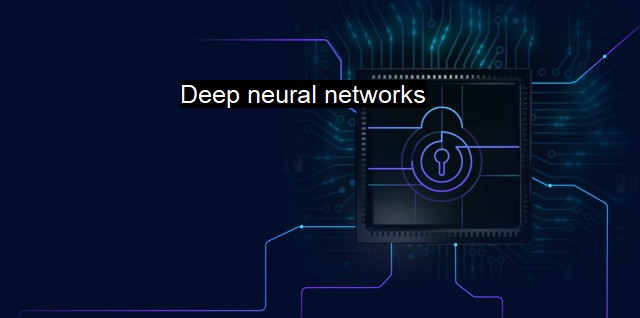What are Deep neural networks?
Revolutionizing Cybersecurity: The Power of Deep Neural Networks for Malware Identification and System Protection
Deep neural networks or DNNs form a subset category of machine learning, involved with algorithms implemented based on the brain's structure and function–aguably like neurons interconnected in a web. These artificial networks aim to simulate the human brain's approach to understanding the world around it: ingesting data through sensors and tweaking the neural network through experiences. Therefore, presented information can be efficiently processed and easily understood.Being multilayered constructs, DNNs are built with multiple processing layers, each consisting of simple processing nodes that can manipulate incoming data. The "depth" of these structures stems from their multilayer nature, a specialization that places deep neural networks above their shallow counterparts. Rather than consisting only of an input and an output layer, DNNs have one or more hidden layers where several levels of computations occur. These hidden layers significantly contribute to a DNNs primary strength – extracting high-level, complex abstractions concealed in massive raw data repositories.
The artificial neurons within the deep neural networks get trained to recognize and interpret complex patterns, thereby becoming efficient over time by building an internal representation of the pattern hierarchies through inputs. Hence, DNNs are extensively applied to scenario analysis, complex data management, forecasting, and decision making.
In the context of cyber security and the use of antivirus software, the enormous potential of deep neural networks becomes evident. Cyber threats and security breaches are currently some of the significant concerns facing organizations handling vast amounts of data. Cyber-attacks tend to be sophisticated and vary significantly, meaning that traditional rule-based, signature-based systems are often insufficient in fending off these attacks.
Deep learning-based network intrusion detection system (N-IDS), which features deep neural networks, provides an ideal solution for contemporary cyber threats. With the ability to feature selection, anomaly detection, and binary and multi-class categorisation, N-IDS significantly elevates the effectiveness in detecting and preventing cyber-attacks. By training the neurons in DNN insights from large-scale network traffic data, the N-IDS provides a more accurate, intelligent, and sophisticated line of defence.
Traditional antivirus software relies on signature-based techniques that search code for known malware signatures. In stark contrast, DNNs in antivirus applications, adopting a behaviour-based approach, detect threats by recognizing patterns indicative of harmful activities. The sophistications embedded in more complex malware can easily be isolated and eradicated by scrutinizing the activities taking place within the data traffic.
DNNs can process enormous amounts of data significantly faster and more efficiently than a human analyst, thus promptly responding to real-time cyber threats. Their self-learning model adapts to rapidly changing cyber environments, relentlessly enhancing cyber-security defences.
Another critical component where DNNs are applied is digital forensics. With the increase in cybercrimes, forensic analyses have been progressively essential. DNNs can efficiently rummage through enormous collections of data, extracting similar file clusters, and quantifying file and network packet similarities for forensics investigations. The development of deep neural networks becomes pivotal in proactively hunting down potential lurking threats and averting catastrophic incidents.
Deep neural networks revolutionize the cybersecurity landscape by initiating a substantial shift from human-performed systems to intelligent, automated, and always-vigilant models in fighting cyber threats. Just as in many contemporary technological contexts, deep neural networks are set to take a front-row seat in organizations of any scale, guarding their extensive data resources, systems and networks from sophisticated strains of malware, and ever-mutating threats. Still, as with all technologies, DNNs are a double-edged sword that could also be exploited for harmful purposes, hence they need to be managed, developed, and applied sophisticatedly.

Deep neural networks FAQs
What is a deep neural network and how does it relate to cybersecurity?
A deep neural network is a type of artificial neural network that is used in cybersecurity and antivirus software to detect and prevent malware attacks. It consists of multiple layers of artificial neurons that can identify patterns and anomalies in data, allowing it to recognize and classify different types of threats.How effective are deep neural networks in detecting malware?
Deep neural networks have been proven to be very effective in detecting malware, especially when compared with traditional antivirus software. They are able to identify both known and unknown threats by analyzing large volumes of data and learning from past incidents.What are the challenges of using deep neural networks in cybersecurity?
One of the main challenges of using deep neural networks in cybersecurity is the need for large amounts of training data. This can be difficult to obtain, especially for emerging threats or attacks that have not been seen before. In addition, deep neural networks can be computationally expensive and require significant resources to run effectively. There is also the risk of false positives, where the network identifies benign files or programs as malware.What are some examples of deep neural network-based cybersecurity solutions?
There are several cybersecurity solutions that use deep neural networks, including network intrusion detection systems, malware detection and classification systems, and predictive threat intelligence platforms. Some examples of these solutions include Darktrace, Cylance, and FireEye.| | A | | | B | | | C | | | D | | | E | | | F | | | G | | | H | | | I | | | J | | | K | | | L | | | M | |
| | N | | | O | | | P | | | Q | | | R | | | S | | | T | | | U | | | V | | | W | | | X | | | Y | | | Z | |
| | 1 | | | 2 | | | 3 | | | 4 | | | 7 | | | 8 | | |||||||